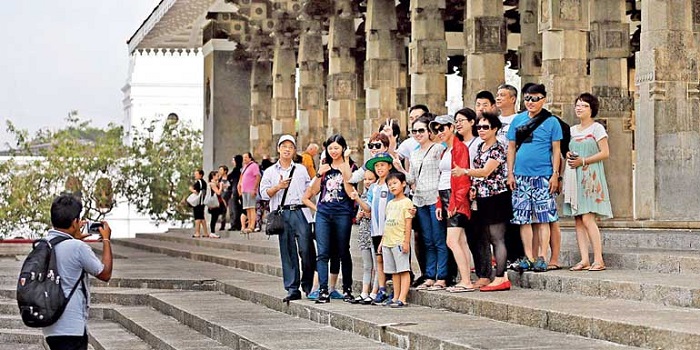- Efforts underway to reach 1mn Chinese tourist arrivals in 2025
- SLTDA shares a road map has been established for this purpose
- SLTDA officials to visit China in coming days to firm up plans for programme
- Key activities include RMB-based tourism activities, SL-Maldives itinerary and making accommodations/sites Chinese-friendly
Sri Lanka is actively working towards increasing the influx of international visitors from China, with plans underway to lure one million tourists in 2025, under the ‘Ni Hao Zhong Guo’ programme.
To capitalise on Sri Lanka being identified as one of the best 20 destinations for tourism by China, discussions and efforts are being rolled out to rapidly increase the tourist arrival rate from that country, so that the island nation can obtain a financial benefit of Rs.225 billion, Sri Lanka Tourism Development Authority (SLTDA) Chairman Priantha Fernando told Mirror Business.
The first Chinese tourist group to Sri Lanka through the Ni Hao Zhong Guo programme is expected to arrive in Sri Lanka between January and February 2024.
While a road map has been drafted, the officials of Sri Lanka Tourism will travel to China in the coming days to firm up the series of activities planned for the endeavour.
Fernando shared that the Social Empowerment State Ministry has been collaborating with its Chinese counterparts to develop the Ni Hao Zhong Guo Smart Tourist Service System, designed specifically for high-profile Chinese tourists.
The programme will also be a platform to promote RMB-based tourism activities for Chinese tourists.
One of the programme’s key components is to launch the Sri Lanka-Maldives itinerary for Chinese tourists, a move that will help increase the tourist arrival numbers from China.
As per the road map, the collaboration of tour operators from both countries is identified as ‘crucial’ to creating a convenient environment for tourists, starting from the initial planning stage of the tour until their return home.
Fernando noted that to provide a travel experience that meets the requirements of Chinese tourists, efforts must be taken to have a Chinese-friendly ‘environment’.
For this, the road map highlighted that Sri Lanka must work towards having hotels/resorts owned, built, purchased or leased by investors from China.
Efforts must also be taken to form joint ventures between China and Sri Lankan hotels.
The road map also calls for the deployment of Chinese guides at airports in Sri Lanka, especially at immigration centres, customs offices in passenger terminals, bank/currency exchanges located in the departure and arrival lobby areas and mobile communication service centres.
Further, making available all descriptive documents in Chinese languages is a key highlight in the road map. The report proposes introducing QR code facilities for a paperless and convenient experience for tourists, hotels and tour facilitators.
However, seat capacities between the two countries remain a major concern and remain to be addressed.











